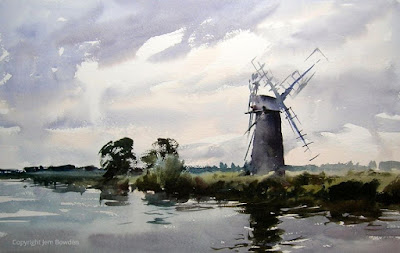As we have already discovered there are several variations of Ultramarine Blue, each pigment batch defined by a five figure number. I think this applies to many other colours, PV19 Quinacridone Rose /Red/Violet being examples.
Ultramarine Blue is the modern synthetic replacement for the original natural Lapis Lazuli. The pigment database www.artiscreation.com. describes it thus `...either the pigment extracted from Lapis Lazuli or the synthetic form Poly sulfide of sodium potassium, lithium or silver alumino-silicate' I hope I've got that all right! We then go to colour shade which is described as: `Deep blue, violet to bright bluish green shades, usually slightly duller in natural forms...' Lapis Lazuli can still be obtained from a very small number of sources and there are purists who will hunt such out but it is exceedingly expensive, while the synthetic Ultramarine is usually in the lowest price range..
Ultramarine Blue is the modern synthetic replacement for the original natural Lapis Lazuli. The pigment database www.artiscreation.com. describes it thus `...either the pigment extracted from Lapis Lazuli or the synthetic form Poly sulfide of sodium potassium, lithium or silver alumino-silicate' I hope I've got that all right! We then go to colour shade which is described as: `Deep blue, violet to bright bluish green shades, usually slightly duller in natural forms...' Lapis Lazuli can still be obtained from a very small number of sources and there are purists who will hunt such out but it is exceedingly expensive, while the synthetic Ultramarine is usually in the lowest price range..
Ultramarine has to be amongst the most popular and widely used paints. In general it doesn't suffer from the surfeit of fanciful names applied to many other paints (pigments). In the majority of cases it is called Ultramarine Blue but also sometimes French Ultramarine, Ultramarine Light or Deep, with a green shade sometimes offered ( W & N). Schmincke rather bizarrely have an Ultramarine Blue made with PB29/ PB15 but also offer `Ultramarine Finest' which is PB29! Daler Rowney do something similar with an Ultramarine Blue but also Permanent Blue which is also PB29..Not having tried these paints I don't know what difference there is in shade between them but looking at the swatches on my col.our chart the Ultramarine Blue looks a deeper more reddish purple with the Permanent Blue `bluer'. The Sennelier French Ultramarine Blue has PV15 as well as PB29 plus both Ultramarine Light and Deep, both PB29. Several makers, Holbein, Maimeri, offer both an Ultramarine Deep and Light. One of the more recent ranges, the reworked DaVinci call their one (PB29) Lapis Lazuli Genuine while also offering both an Ultramarine Blue and the same again `green shade'. The latest `sensation', the ultra expensive QoR are similar to Sennelier in that PV15 is added to the PB29 and called French Ultramarine Blue. I could go on but is there any point in doing so? I have no real preferences in this colour and will almost certainly give Lukas a try, with both a light and a deep as they are such great value. Currently I have a little Graham Ultramarine and a new tube of Holbein.I've used several makes in the past and have a slight feeling that the ones called French Ultramarine are brighter but I haven't done a proper comparison so may be wrong.
It has been suggested that a possible alternative to Ultramarine Blue is Indanthrene or Indanthrone Blue which is PB60. This is one of the darkest value paints but on the dull side. I mainly use Ultramarine Blue to produce darks (or even greys) coupled with Burnt Sienna, Burnt Umber or Translucent Brown (Schmincke Pbr41)) , this latter colour resembling a brighter Burnt Sienna. There are other alternatives like some of the reds which will make very strong darks. Plenty to choose from!
Not much more to say really with personal preference playing it's usual part in determining what you buy.





















